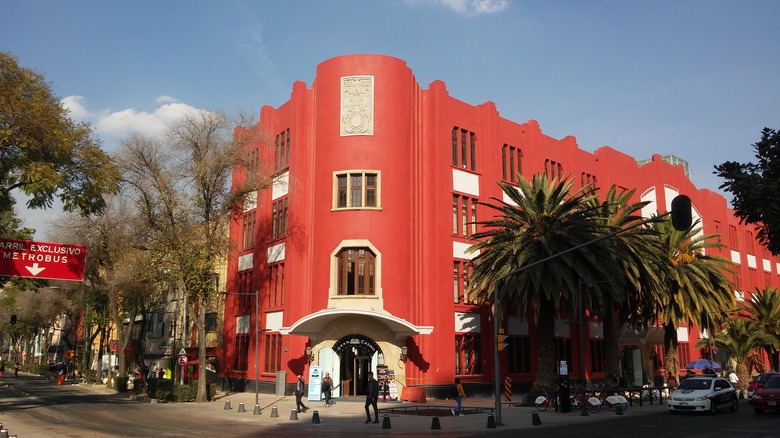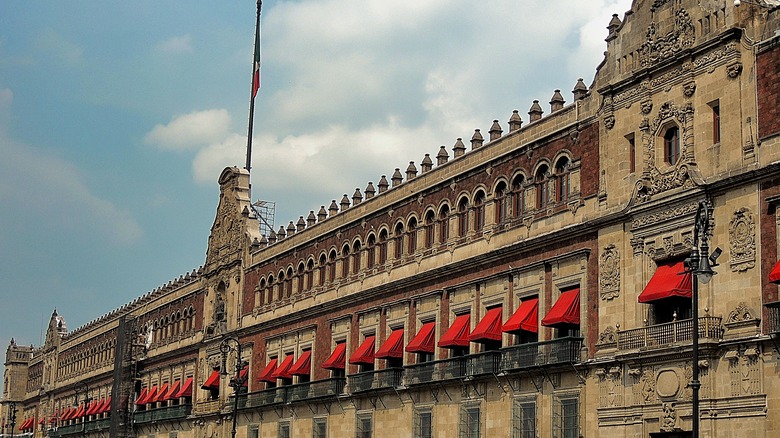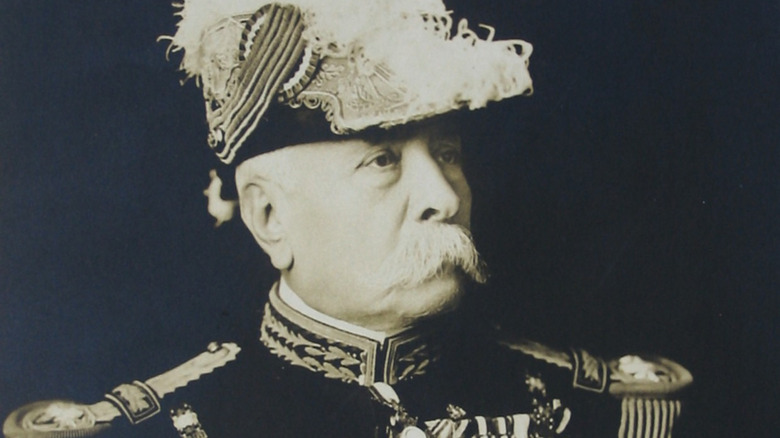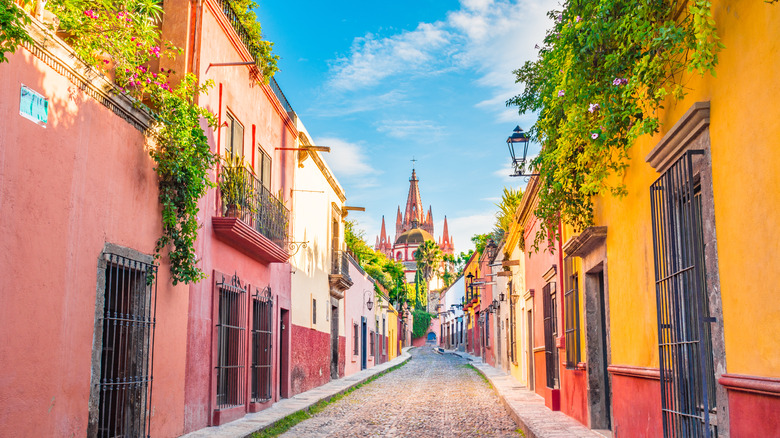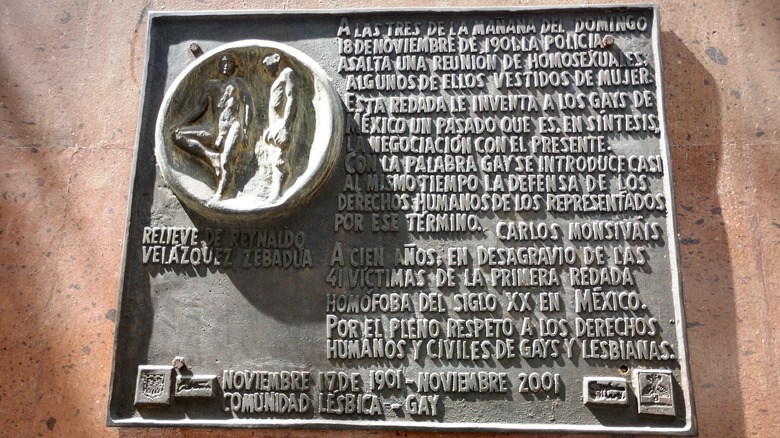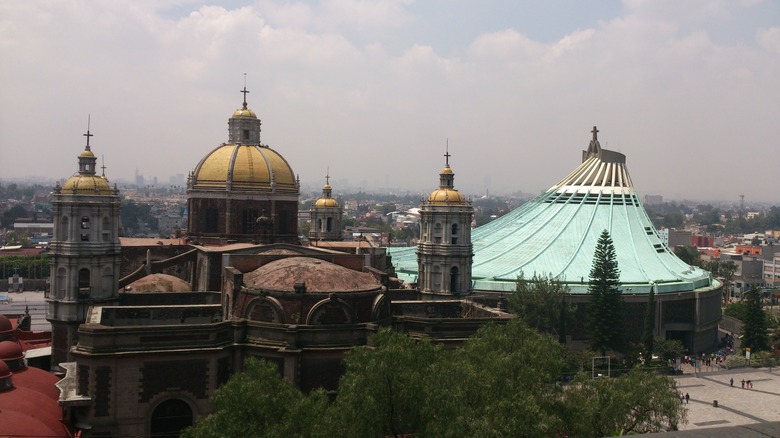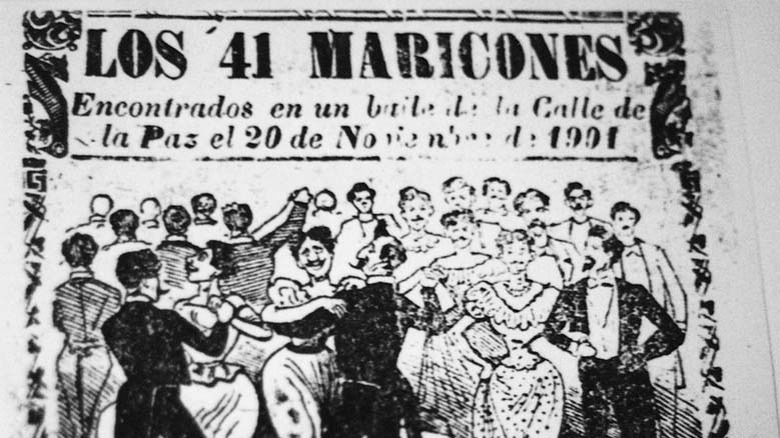How A Secret Drag Ball Changed Mexico Forever
One night, in November 1901, the police raided a house party in Mexico City. This wasn't just any house party, however. It was, in fact, a ball attended by 41 of Mexico's elite — all men — approximately half of whom were dressed in women's clothes. Everyone was arrested, and many were sent to do menial labor in the Yucatan — without a trial. A full list of the men arrested and involved has never been released — and likely never will be, as the records were ordered to be destroyed by the government. However, the more something is hidden, the more interesting it can become to the public and the press ...
The scandal that ensued afterwards was quickly picked up by journalists, as well as various poets and artists. There were persistent rumors that a supposed 42nd man was the son-in-law of Mexico's then-President Porfirio Díaz, and had his name quickly struck from the record. Thereafter, the scandalous event came to be known as the Dance of the 41, writes History. It was the first time that homosexuality was really discussed in the Mexican press, and the number 41 quickly became a hallmark of shame for many Mexicans, so much so that some people would even avoid celebrating their 41st birthdays. Recently, several LGBT+ Latinos have set out to change this attitude, but progress has been slow. Regardless, the Dance of the 41 changed Mexico's view of sexuality forever.
The origins of the Dance of the 41 are still unclear
A group of gay men in the upper echelons of Mexican society often met secretly over the course of the year 1901, to drink, have intercourse, and generally make merry. Towards the end of that year, they conceived the idea of having a dance with half of the participants in women's dress. The details of the event were passed around through cantinas, and therefore to people in different social classes, writes History.
Due to the government hushing up whatever they could after the scandal broke, it is unclear exactly who was in attendance, or even who organized the event, as the names collected by the police were never released. Antonio Adalid — godson of former Mexican Emperor Maximilian I — attended the event, and recalled a sexual raffle of a young man, which he won, according to Lucas Espinoza and Rosalva Resendiz's "The Secrets of the Raid of the 41: A Sociohistorical Analysis of a Gay Signifier." Due to the subsequent destruction of records by the Mexican government, it is difficult to pin down the inception or organization of the event with any real certainty, though some names of participants have since been uncovered over the years.
The dance bridged Mexico's growing wealth divide
By 1901, Mexico's President Porfirio Diaz had been in power for 25 years, with a government that many considered to be corrupt. There was a considerable distance between the upper and lower classes, due to the government's focus on the elites, writes ThoughtCo, as well as the subjugation of the lower classes. Many farmers had to become laborers, and indigenous workers were occasionally forced into indentured servitude.
Diaz spent much of his energy focusing on industrial progress in Mexico, but didn't update the political system at the same time, according to the Library of Congress. He manipulated many of his governors and mayors, working to play them off of one another. Overall, social inequality was growing rapidly around the beginning of the 20th century, writes the Library of Congress. The Dance of the 41 managed to briefly bridge that gap by inviting people of different social classes; Even though they were a mix of rich and poor, all of the men who attended were willing to enjoy the event together. On the other hand, the government's focus on punishing the mainly well-to-do dancers showed the lower classes that upper-class men could indeed be held accountable for their deeds. This might have planted the seeds of the forthcoming Mexican Revolution, which began in 1910 after Diaz attempted to stay in power longer than he should have, and jailed his competitor Francisco Madero.
The police raided the dance in the middle of the night
In the middle of the night of November 17, 1901, the police raided a house party in the Tabacalera neighborhood of Mexico City and arrested everyone present, including 19 men who were dressed in women's clothing, wearing makeup, and adorned with extravagant jewelry (via History). One of the 19 men in feminine clothing was a young man, named Antonio, who was raffled off at the Dance as a sex worker (via Lucas Espinoza and Rosalva Resendiz's "The Secrets of the Raid of the 41: A Sociohistorical Analysis of a Gay Signifier"). Though initially the number of participants was reported as 42 men, it was later changed to 41, writes America's Quarterly.
Though participants were from all social classes, the most prominent members at the Dance of the 41 were from the upper classes. To avoid roiling up the public too much, the police quickly took all of the men into custody, though several wealthy families paid for their sons' release hours later, to avoid further scandal. These well-connected partygoers included Antonio Adalid — the former Mexican Emperor Maximillian I's godson, according to Espinoza and Resendiz. Adalid, who when dressed as a woman took the name Toña, was disowned after the scandal broke, despite being dressed in masculine attire at the dance.
The dancers faced a humiliating aftermath
After being arrested, the 19 men at the dance found wearing women's dresses were forced to walk the streets of Mexico City in the same attire, before being sent to the Yucatan to perform menial labor in the military. It's possible that they didn't actually fight but instead were obliged to serve as maids in the army. None of the men received a trial and many of their names weren't recorded, as documented in Lucas Espinoza and Rosalva Resendiz's "The Secrets of the Raid of the 41: A Sociohistorical Analysis of a Gay Signifier." Mexico's president Porfirio Diaz had the police records removed afterwards, in an attempt to erase the scandal altogether.
Decades later, historian Juan Carlos Harris found the names of several men in the Suprema Corte de Justicia de la Nación, and the event itself is commemorated by a memorial plaque in Mexico City, per Atlas Obscura. Technically homosexuality was not a crime in Mexico at the time of the event, so the men were charged with "crimes against decency" instead, to make an example of the group. Seven men out of the 19 charged had written protections against being in the military, but the punishment was carried out nonetheless (via Espinoza and Resendiz). Overall, however, punishments were not equal for the dance's participants, as the men in masculine attire said they weren't aware of their partners' attire and were thus freed, or simply paid for their freedom.
Homosexuality was shunned by the Mexican media at the time
Before the Dance of the 41, homosexuality in Mexico was a taboo subject for the media, and the scandal of the dance was the first time this topic was broached by the press. The ballad "El baile de los 41 maricones," written by Jose Guadalupe Posada, rapidly spread the story to the public and the media, according to Lucas Espinoza and Rosalva Resendiz in "The Secrets of the Raid of the 41: A Sociohistorical Analysis of a Gay Signifier." The song, as much as the scandal itself, brought homosexuality into Mexico's public discourse.
Carlos Monsiváis writes in Letras Libres that little was publicly known of homosexuality before the scandal, though impressions were generally negative. Homosexuality was seen as an affliction and decried as such, with the "traditional" ideals of sexuality being lauded instead.
Ultimately, the Mexico City police and the governor weaved accepted gender roles into the punishments for the 19 men who were found at the dance wearing women's clothing. Instead of being sent to the Army to fight as front-line troops, they instead might have served in the military as maids, per "The Secrets of the Raid of the 41: A Sociohistorical Analysis of a Gay Signifier." They were thus punished by being further shamed for how they expressed their gender, which was wholly at odds with Mexican society at the time.
Mexico reacted to the scandal with disgust and fascination.
Once the story broke (though the government tried to hide it), the Mexican public was both fascinated and horrified by the Dance of the 41, and the event continued to be mocked as time went on. A famous ballad was written almost immediately, solidifying the scandal for many people, according to Lucas Espinoza and Rosalva Resendiz's "The Secrets of the Raid of the 41: A Sociohistorical Analysis of a Gay Signifier." The artist Jose Guadalupe Posada also produced illustrated broadsheets that illuminated the scandal for Mexicans in a humorous light; these were widely distributed, and Posada is now well known for his work depicting Mexico's elite.
The working class also took the scandal as an encouragement to associate homosexuality solely with the glamorous elite class, and to see themselves instead as the true masculine side of Mexico. This response became as much about social class warfare as it did a reaction to a scandal, write Espinoza and Resendiz.
The newspaper El Popular, while writing about the scandal, added, "We will not give our readers more details for being grossly disgusting" (via InfoBae). The Mexican public also wanted to be sure everyone had been punished, so much so that the police wrote press releases explaining how every man from the dance had been sent to the Yucatan to fight; even so, it was clear some men had their freedom paid for.
Scandal and rumors surrounded the dance
The number of men was first counted as 42, but that number was later revised to 41. Rumors still persist that the last man was Ignacio de la Torre y Mier, the son-in-law of Mexico's then-President Porfirio Díaz, and his name may have been struck from the list to avoid scandal. Ironically, however, this action instead added to the rumors and scandal already flying around the event, and the government's control of it, writes History.
Lucas Espinoza and Rosalva Resendiz's "The Secrets of the Raid of the 41: A Sociohistorical Analysis of a Gay Signifier" describes how the press' handling of the scandal was very much formed by class privilege, and that is clearly seen in de la Torre's case. Díaz told his daughter Amada about her husband's activities — though she had suspected for some time — but what made everything worse was when the press got stuck in; Jose Posada drew de la Torre prominently on the front of one of his leaflets, which depicted the dancers in an unflattering light. Though de la Torre was said to have been dressed in a suit at the dance, Posada drew him in a gown. This caricature added fire to the salacious rumors about him, while adding a sharp element of humor to the affair.
Mexico's view of sexuality changed afterwards
The Dance's main legacy is that it was the first event that truly opened up discussions of homosexuality in Mexico, according to History. Though still not fully accepted, the Dance of the 41 began the process of building tolerance and respect for Mexico's LGBT+ community. In regards to sexuality at the time, Dr. Robert McKee Irwin said (via History), "It was something that was totally repressed in the 19th century but it was there. And I think maybe it was out and this is what brought it out."
Other balls and similar events were raided afterwards, though of all these, the Dance of the 41 received the most attention from the Mexican press and public. According to Lucas Espinoza and Rosalva Resendiz's "The Secrets of the Raid of the 41: A Sociohistorical Analysis of a Gay Signifier," the working class mainly saw homosexuality as being a negative commonality with the rich elites, who hosted the Dance of the 41 in the first place. As time went on, with the Mexican Revolution only a few short years away, the working class felt that they were the only representation of true masculinity in their country. As decades passed, prominent Mexicans began to come out as gay, including poet Salvador Novo, as society continued to change and grow more accepting.
The number 41 took on a new meaning in Mexico
After the scandal of the dance, the number 41 came to be negatively associated with homosexuality. This grew to the point where it wasn't used in hotel rooms or street addresses, and people who were 41 years old would even say they were "30 [and] 11" years old instead, write Lucas Espinoza and Rosalva Resendiz in "The Secrets of the Raid of the 41: A Sociohistorical Analysis of a Gay Signifier." The concept of systematically erasing an entire number from one's culture because of the negative connotations around a scandal from years ago is horrifying to contemplate.
The number 41 was used as a virulent slur in Mexico for decades, and had such a major cultural stigma that its significance can't be overstated. America's Quarterly writes that the number was written out of military and police units, and avoided at all cost. The history behind the number's significance was eventually forgotten by many, and 41 began to symbolize institutionalized homophobia and enforced masculinity across Mexico, write Espinoza and Resendiz. Activist Alberto Mendoza told the Philadelphia Gay News that he was excited by being nicknamed "41" by his friends, until his father told him that it indicated other slurs that all pointed to homophobia. Overall, binary gender and homophobia were reinforced across Mexico by this new meaning of 41.
Revisiting Dance of the 41 today
More recently, LGBT+ Mexicans have been revisiting the scandal as a prideful historical moment for themselves. Though it may have been a dark scandal for Mexico once, it doesn't always have to be, as being able to reinvent scandals can be a positive thing for the communities involved. According to the Philadelphia Gay News, Alberto Mendoza began a project to honor 41 LGBT+ Latinos each year, thereby helping to reclaim the number for the LGBT+ community, and stop the shame from the scandal from continuing to trickle down through the generations. He has celebrated both the living and the dead, to remember their legacies.
Though the scandal of the Dance of the 41 wasn't looked on well by Mexican society for decades, and still isn't by some, the work being done by the LGBT+ Latino community to recapture the number for themselves is a positive step for the community as a whole, and for the concept of acceptance across Latin America.
"It isn't just about 41. It's really about how we're connected as LGBTQ Latinos. At the core of our challenge is still mostly culture that is homophobic, religion that is homophobic, and family that can be homophobic," said Mendoza (via the Philadelphia Gay News). "I think we're all much more empowered when we can take things that are negative and finally reclaim them."
